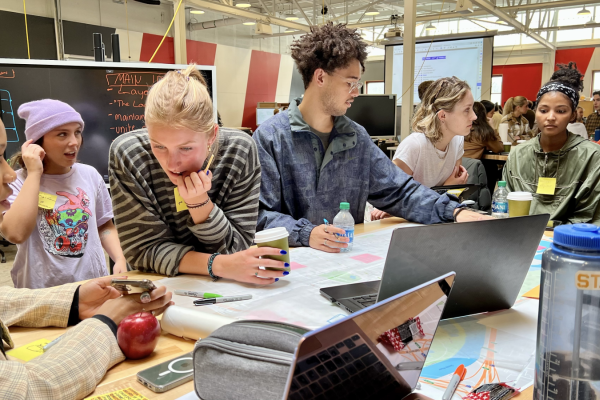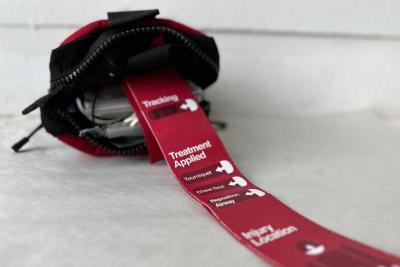Ohio State’s industrial design program charting path for changing landscape

When Ohio State students decide to pursue industrial design within the Department of Design, they can rest assured knowing they are learning from the industry standard.
Three professors in the program — assistant professor William Nickley and associate professors Amanda Huynh and Sébastien Proulx — have won education awards from the Industrial Designers Society of America (IDSA) in the past three years, with Nickley receiving the prestigious IDSA Young Educator Award in September.
"One of my favorite interviewers, Terry Gross, longtime host of NPR’s ‘Fresh Air,’ talks about how the best conversations are when both people leave having learned something new,” Nickley said in accepting the award. “I think that’s what education is: an exchange, a dialogue."

Huynh, who joined the Department of Design in August and said she is excited for the opportunity to impact students and make her mark at Ohio State, won her Young Educator Award in 2023. These awards and accomplished educators put the department and the industrial design program in rare air, and have allowed those in the program to continue building the future of industrial design at Ohio State.
“People in our industrial design program are trained in the social sciences to understand how people live, want to live or what are their needs and desires,” said Proulx. The role of these innovators, he added, is to create, design and develop these products to improve our collective quality of life. Those foundations have existed since the early days of industrial design, though the field continues to evolve.
“The industrial design program at Ohio State has a long history of responding to social changes,” said professor and department chair Fabienne Münch. “At its inception in the late 1960s, industrial design was taught under hands-on design principles originating from Germany, the U.K. and Italy, for designers to solve human-centered problems.”
These problems and their solutions can range from traditional design decisions, such as making a mug more comfortable to hold , to broader design philosophy, such as designing something with sustainability for the environment in mind.
Alumni Martin Keen ’89, founder of KEEN Footwear, approached his post-graduate career with both viewpoints, designing an outdoor shoe brand with a focus on reducing environmental impact. But this is just one example of how industrial design at Ohio State and those around the program are combining the past, present and future.
“With the advent of major societal, economical, technological and environmental transformations,” Münch said, “the industrial design program has become a destination for studying design research, co-design, interaction design and systemic thinking, in addition to industrial design fundamentals.”
Hands-on experience in industrial design
The principles of industrial design are seen in work done by students within the industrial design major. Easton Nguyen and Zoë Shay-Tannas, both of whom received their Bachelor of Science in Design this spring and are now pursuing graduate degrees overseas, recently received Core77 Design Awards highlighting excellence of students in design.
Shay-Tannas received a commercial equipment award for PullTagTM, a triage tag developed in partnership with Columbus-based research organization Battelle, that allows first responders to quickly capture patient information during mass casualty events. It took a significant amount of research to develop her project — including consultation with the Columbus Fire Department to learn their needs in the field — but that research is at the core of industrial design, which set her up for success.

“I got a lot of skills (from Ohio State),” she said, “but the strongest part of the program was the amount of research we were able to do regarding our designs. … When I was designing the pull tag, I didn't know anything about firefighting, emergency response, mass casualty or mass casualty response. But I had those tools that the program gave me to be able to observe the ways that would help inform design decisions and ask the right questions.”
While the foundation of industrial design remains focused on designing products and services, it’s a rapidly evolving field that has grown to include user interface/user experience, sustainable practices, social innovation and artificial intelligence. Nguyen combined several of these areas for “Exit the Rat Race,” a multi-pronged senior capstone project that shows future scenarios of consumerism gone wrong, and received the Editor’s Choice award from Core77.
Much of the education within the industrial design program at Ohio State focuses on preparing students for this ever-changing landscape, and that approach is appreciated by the students. Nguyen’s award-winning project was wide-ranging, reflective of his experience within the industrial design program.
“If you like to visualize through sketching and that's how you want to do all your projects, you can keep doing that,” he said. “If you want to do rendering, you can keep doing that. They let you do what you want and keep pushing that, and it still fits in the curriculum.”
Industrial design in the field
Nguyen and Shay-Tannas’ projects showcase many of the possibilities within industrial design, with post-graduate careers for students ranging from product design, user interfaces and design research to work in the public sector, all requiring the innovation and critical thinking skills offered in the program.
In addition to paths taken by alumni such as Keen, other graduates have gone on to work in design consultation, education, medical and various scientific fields, with those foundations of design necessary across numerous disciplines.
“We have students who end up, especially at the beginning of their career, as product designers,” Proulx said. “They are in charge of computer-aided design and computer models for products and doing product development, research and development.
"We have students that go down the field of service design (improving experiences for consumers) and UX design, designing apps for phones. … Then we have a number of people that are working in industry like innovation, and also in the public sector.”
And with world-class educators leading the charge, the future remains bright for industrial design at Ohio State.
“I moved here from Pratt Institute in Brooklyn, New York, so one of the questions I’ve been asked frequently is, ‘What made you make the move?’” Huynh said. “And my answer has been that it’s a combination of the students that I’ve met (who are so thoughtful and engaged), the incredibly supportive colleagues, and the next-level opportunity that being at a place like Ohio State can provide.”

